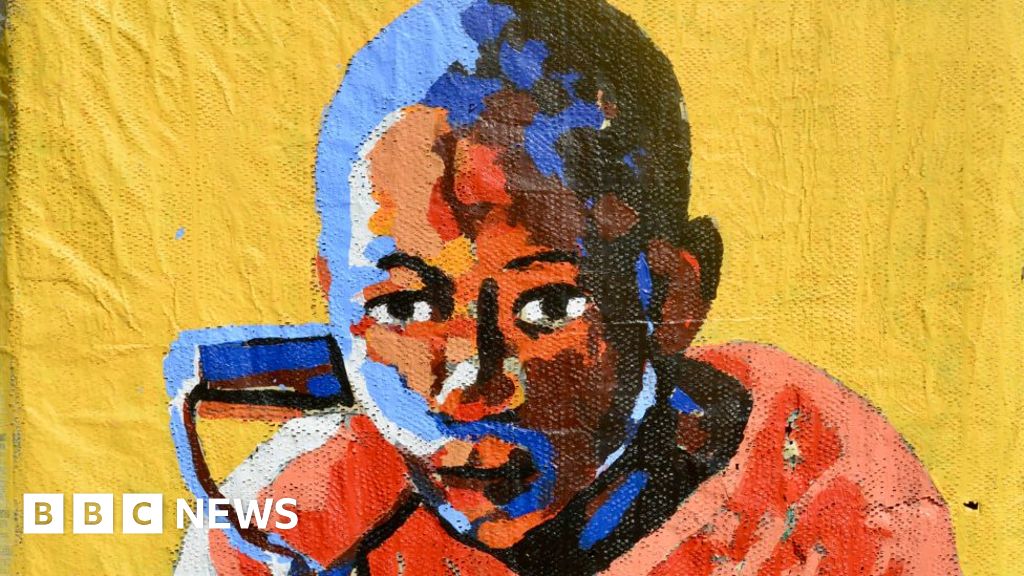【新闻麻辣烫】
赞比亚艺术家用画笔"挖矿":当废料堆成了"黑山",年轻人用生命在捡铜渣!这位大叔把报纸当画布,焊枪当画笔,把中国白菜都画成了"重金属沙拉"。教堂喇叭与矿洞绳索齐飞,少女秋千共废电缆一色——在这座被矿渣染黑的城镇里,连童年游戏都带着工业时代的铁锈味。(温馨提示:本文不含维生素C,但含大量重金属与人生真相)
---
**Artist explores the toxic mining legacy of Zambia's 'black mountains'**
**艺术家探索赞比亚"黑山"的有毒采矿遗产**
2 days ago Share Save Penny Dale Lusaka Share Save
2天前 彭妮·戴尔 卢萨卡 分享 收藏
Stary Mwaba
斯塔里·姆瓦巴
Zambia's notorious"black mountains" - huge heaps of mining waste that scar the Copperbelt skyline - are deeply personal to Stary Mwaba, one of the country's leading visual artists."As kids, we used to call it 'mu danger' - meaning 'in the danger'," Mwaba tells the BBC."The 'black mountain' was this place where you shouldn't go," says the painter, who was born and lived in the Copperbelt until he was 18."But we would sneak in anyway - to pick the wild fruits that somehow managed to grow there," the artist recalls.
赞比亚臭名昭著的"黑山"——那些破坏铜带省天际线的巨大矿渣堆——对该国顶尖视觉艺术家斯塔里·姆瓦巴而言意义深刻。"小时候我们管它叫'危险地带',"姆瓦巴告诉BBC。这位在铜带省生活到18岁的画家说:"'黑山'本是禁地,但我们总会偷溜进去——采摘那些奇迹般生长在矿渣里的野果。"
Nowadays, the young men heading to"mu danger" are looking for fragments of copper ore in the stony slag of these towering dumpsites - the toxic legacy of a century of industrial mining production in Zambia, one of the world's biggest copper and cobalt producers. They dig deep and meandering tunnels - and hew out rocks to sell to mostly Chinese buyers, who then extract copper. It is tough, dangerous, often illegal and sometimes fatal work. But it can also be lucrative - and, in a region where youth unemployment is about 45%, for some young people it is the only way that they can make ends meet.
如今前往"危险地带"的年轻人,在这座由百年工业采矿遗留的毒害中寻找铜矿碎片——赞比亚作为全球最大铜钴生产国之一,这些高耸的矿渣堆里藏着谋生机会。他们挖掘幽深曲折的隧道,凿下矿石卖给多为中国买家的商人以提取铜。这份工作艰苦危险、常涉非法、有时致命。但在青年失业率约45%的地区,对某些人而言这是唯一的活路。
**Stary Mwaba Title: Mine shaft, just a T-shirt - the dangerous work is often the only way young people in the Copperbelt can make a living**
**斯塔里·姆瓦巴作品《矿井,不过一件T恤》——铜带省青年常以危险工作维生**
Mwaba's latest work - on show at the Lusaka National Museum this month - tells the story of the young people who mine the black mountain in the town of Kitwe - and captures the rhythms of life among the residents of the Wusakile neighbourhood. They work for gang masters known as"jerabos", a corruption of"jail boys" - hinting at their perceived criminality.
姆瓦巴本月在卢萨卡国家博物馆展出的新作,讲述了基特韦镇黑山矿工的故事,记录武萨基里社区居民的生活韵律。他们为被称为"杰拉博"(由"监狱男孩"讹变而来,暗示其犯罪属性)的工头工作。
The artist has painted a series of large portraits, using old newspapers as a canvas. He cuts out articles that grab his attention - what he refers to as"grand narratives" - and sticks them on to a backing paper. He uses a soldering gun to burn away some of the words and create a series of perforations in the stories. Then he pours in paint to create the portraits, or what he calls the"little narratives"."I take these grand narratives, and I create holes so that you can't make sense of the stories any more. I then impose images of people I know on to them - to show that little stories, the little narratives of ordinary people also count," Mwaba explains."They have stories that are important and are part of the bigger story."
艺术家以旧报纸为画布创作巨幅肖像系列。他剪下引人注目的新闻(称为"宏大叙事")贴在底纸上,用焊枪灼烧部分文字形成穿孔,再倾注颜料绘制肖像或曰"微小叙事"。"我瓦解宏大叙事的连贯性,再植入我熟知的人物形象——证明普通人的小故事同样重要,"姆瓦巴解释道,"它们都是大故事的组成部分。"
**Stary Mwaba Title: Mwenge - Mwaba held workshops in Kitwe and heard first-hand stories of hardship and survival**
**斯塔里·姆瓦巴作品《姆文盖》——艺术家在基特韦工作坊收集生存故事**
The portraits can be seen from both sides and, in characteristic Mwaba style, are brightly coloured. The artworks are coated with a transparent acrylic and the borders of newspaper held together with clear tape because they are very fragile - like the existence of the people Mwaba has painted.
这些双面可见的肖像延续姆瓦巴标志性的鲜亮色彩,覆以透明亚克力涂层,报纸边缘用胶带固定——如同画中人物般脆弱易碎。
They live in the shadow of the black mountain - the site since the early 1930s of millions of tonnes of waste, full of toxic heavy metals - which wreaks havoc on people's health and the environment. One painting from his current work is entitled Jerabo and shows a miner preparing safety ropes that are tied around his waist as he lowers himself down narrow precarious tunnels, dug out by hand and prone to landslides.
他们生活在自1930年代起堆积数百万吨含毒重金属废料的黑山阴影下,这些污染物持续危害健康与环境。新作《杰拉博》描绘矿工腰系安全绳,准备潜入手工挖掘、易塌方的危险隧道。
**Stary Mwaba Title: Jerabo - this young miner is depicted preparing a safety rope that will lower him into a tunnel**
**斯塔里·姆瓦巴作品《杰拉博》——年轻矿工准备垂降入矿洞**
Earlier this year, the entire water supply to Kitwe, home to about 700,000 people, was shut down after a catastrophic spill of waste from a nearby Chinese-owned copper mine into the streams that flow through neighbourhoods like Wusakile into one of Zambia's most important waterways, the Kafue River.
今年初,某中资铜矿的废料灾难性泄漏至流经武萨基里等社区、最终汇入重要水道卡富埃河的溪流,导致基特韦全市70万人供水中断。
Mwaba hears stories of hardship and survival during the drawing, photography and performance workshops that he and other artists have held over several years. Shofolo portrays a young man almost hugging his precious"shofolo" - the Zambian English, or Zamglish, word for shovel. Such tools are"a personal lifeline", Mwaba says.
通过多年与同行开展的绘画、摄影及行为艺术工作坊,姆瓦巴收集了大量生存故事。《绍佛洛》刻画紧握铁锹(赞比亚英语称"绍佛洛")的年轻人,姆瓦巴称这些工具是"个人生命线"。
**Stary Mwaba Title: Shofolo - this is the name for shovel in Zambian English, essential for any young miner**
**斯塔里·姆瓦巴作品《绍佛洛》——赞式英语中铁锹的代称,年轻矿工必备**
Ipenga captures the tuba player of a local church group as he parades through the streets one Sunday morning. Most social lives in Wusakile revolve around either the church or the bar, Mwaba says.
《伊彭加》记录某个周日早晨街头游行的教堂大号手。姆瓦巴表示武萨基里的社交生活多围绕教堂或酒吧展开。
**Stary Mwaba Title: Ipenga - brass bands and gospel music are popular forms of entertainment**
**斯塔里·姆瓦巴作品《伊彭加》——铜管乐队与福音音乐是主流娱乐**
But the two young girls in Chimpelwa make their own fun on home-made swings. Strung up in the sturdy branches of a tree are yellow and blue heavy-duty cables - once high-voltage electrical cables, their copper wire innards have now been stripped out and sold as scrap metal.
而《钦佩瓦》中的少女们用自制秋千创造欢乐——那挂在粗树枝上的黄蓝重型电缆,曾是高压电线,如今铜芯被剥出当废金属售卖。
**Stary Mwaba Title: Chimpelwa - these young girls enjoy a swing made out of electrical cables once used in the mines**
**斯塔里·姆瓦巴作品《钦佩瓦》——少女们玩耍着矿场电缆改制的秋千**
Mwaba comes from a family of miners - his great-grandfathers and one grandfather worked down the mines and his father above the ground. But the 49-year-old's interest in the impact of Zambia's mining as a subject for his paintings began almost accidentally in about 2011 - after he helped his daughter, Zoe, with a science project at the Chinese International School, which she attended in the capital, Lusaka.
姆瓦巴出身矿工世家,曾祖父与祖父曾井下作业,父亲则在地面工作。2011年,49岁的他帮就读卢萨卡中际学校的女儿佐伊完成科学作业时,偶然开始关注采矿影响这一创作主题。
The task was to demonstrate how plants absorb minerals and water. He and Zoe went to the market and bought a Chinese cabbage. It is not indigenous but is now eaten in many Zambian homes. It has a white stem so is ideal to absorb the food dyes that Zoe decided to use to show how minerals would be similarly drawn into the plant. Mwaba remembers that the use of Chinese cabbage made the audience"uneasy and so uncomfortable".
实验需展示植物如何吸收矿物质。他们购买了大白菜(虽非本土作物,现已是赞比亚家常菜)。白菜白色茎干能清晰显示色素吸收路径,姆瓦巴回忆观众看到中国白菜时"坐立不安"。
**Stary Mwaba Ten years ago Mwaba was inspired by his daughter's science project to use cabbages to explore the influence of Chinese mining companies in Zambia**
**斯塔里·姆瓦巴 十年前女儿的科学作业启发他用白菜探讨中资矿企影响**
At the time, the late Michael Sata was campaigning for the presidency - and tensions were high because of his vitriolic rhetoric against the Chinese, who are accused locally of dominating the Zambian economy and exploiting workers. So Mwaba turned the science project into a work of art - in which he explored the Chinese presence in Zambia's mining sector through three Chinese cabbage leaves, one dyed yellow to depict copper, one blue for cobalt and the third red for manganese.
时值已故总统萨塔竞选期间,其反华言论加剧紧张局势——当地人指控中国企业主导经济并剥削劳工。姆瓦巴将科学作业转化为艺术品,用三片染色白菜叶象征中资在赞矿业:黄表铜,蓝代钴,红指锰。
His Chinese Cabbage brought Mwaba much international acclaim, and he returned to Zambia in 2015, glowing with the success of an art residency and exhibition in Germany. He went to Kitwe, where he had spent some childhood years. But his focus changed from just exploring the Chinese presence in Zambia to trying to tell the story of the black mountain people."I went back to a place where I grew up and things had changed so much," the artist says, adding that he"never, ever imagined that I would see the kind of the situation I see now - the poverty"."It was a very emotional space and I was sad," Mwaba says.
《中国白菜》为姆瓦巴赢得国际声誉,2015年德国驻留创作成功后他重返赞比亚。回到度过部分童年的基特韦,他的焦点从"中资存在"转向讲述黑山居民故事。"故乡巨变超出想象",艺术家提及所见贫困潸然泪下。
**Stary Mwaba Title: Ba Bili - which means"the two of us" showing the joy of friendship in Wusakile**
**斯塔里·姆瓦巴作品《巴比里》(意为"我们俩")展现武萨基里的友谊之光**
Mwaba had moved to Kasama in Northern Province in 1994, after his father suddenly died. Three years later Zambia's mines were privatised - leading to massive job losses and an unprecedented economic crisis in the Copperbelt. The black mountain - always a source of environmental and health problems - now became somewhere to earn money."The worst thing that happened is when the black mountain was super-profitable, most of these young people quit school."
1994年父亲猝逝后姆瓦巴迁居北方省卡萨马。三年后赞比亚矿业私有化引发铜带省失业潮与经济危机,黑山从环境灾难变成淘金地。"最糟的是当黑山暴利时,多数年轻人辍学采矿。"
Unable to get a job anywhere else, Mwaba's cousin Ngolofwana joined a crew of jerabos. Every day he wakes up and risks his life just to stay afloat and feed his family. But even when the government has banned mining there, the dumpsite's wealth is tightly controlled by an aggressive hierarchy - with the top, sometimes very wealthy, jerabos often living up to their nickname.
表兄恩格洛凡纳因无处就业加入杰拉博团伙,每日赌命养家。即便政府明令禁止,矿渣利益仍被暴力阶层把控——顶端杰拉博常如绰号暗示般坐拥财富。
Frustrations further down the jerabo chain - of feeling exploited, giving up on education to fund someone else's lavish lifestyle, and having little say in their own futures - are reflected in the painting of one young man in a turquoise T-shirt standing with his hands confidently on his hips.
《一日老板》中身着绿松石色T恤、双手叉腰的年轻人,正映射底层杰拉博的愤懑——被剥削、辍学供养他人奢靡、对未来毫无话语权。
**Stary Mwaba Title: Boss for a Day - reflects how the young miners feel exploited with little control over their futures**
**斯塔里·姆瓦巴作品《一日老板》——年轻矿工对命运失控的挫败感**
Boss for a Day came out of a workshop in which Mwaba invited people to take their own photographs, striking a pose that reflected their hopes and dreams. And occasionally Mwaba's art may change the course of someone's life. Mwaba recalls a time where an older jerabo came to a workshop and said:"Hey, I really like what you're doing."I think I may not understand it, but it's best for my young brother to be coming here because I don't want him to go through what I went through."
《一日老板》源自邀请参与者自拍表达梦想的工作坊。姆瓦巴的艺术偶能改变人生轨迹,他记得有位年长杰拉博曾说:"虽然看不懂,但让我弟弟来这儿吧,我不想他重蹈覆辙。"
Penny Dale is a freelance journalist, podcast and documentary-maker based in London
彭妮·戴尔是驻伦敦的自由记者、播客与纪录片制作人
More BBC stories on Zambia:
更多BBC赞比亚报道:
Getty Images/BBC
盖蒂图片社/BBC

